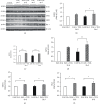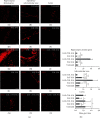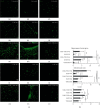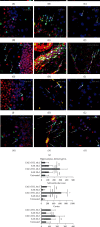Olive Leaf Polyphenols Attenuate the Clinical Course of Experimental Autoimmune Encephalomyelitis and Provide Neuroprotection by Reducing Oxidative Stress, Regulating Microglia and SIRT1, and Preserving Myelin Integrity
- PMID: 32802267
- PMCID: PMC7415106
- DOI: 10.1155/2020/6125638
Olive Leaf Polyphenols Attenuate the Clinical Course of Experimental Autoimmune Encephalomyelitis and Provide Neuroprotection by Reducing Oxidative Stress, Regulating Microglia and SIRT1, and Preserving Myelin Integrity
Abstract
Numerous evidences suggest that plant polyphenols may have therapeutic benefits in regulating oxidative stress and providing neuroprotection in many neurodegenerative diseases, including multiple sclerosis (MS). However, these mechanisms are not yet completely understood. In this study, we investigated the effect of olive leaf polyphenols on oxidative stress through oxidation marker level and activity (TBARS, SOD, and GPX) and their protein expression (SOD1, SOD2, and GPX1), as well as the protein expression of Sirtuin 1 (SIRT1) and microglia markers (Iba-1, CD206, and iNOS) and myelin integrity (proteolipid protein expression) in the brain of rats with induced experimental autoimmune encephalomyelitis (EAE) and subjected to olive leaf therapy. Experiments were performed in male EAE DA rats, which were randomly divided into 2 main groups: EAE groups treated with the therapy of olive leaf (EAE+TOL) and untreated EAE control groups. The EAE treated groups consumed olive leaf tea instead of drinking water (ad libitum) from the beginning to the end of the experiment. In addition, olive leaf extract was injected intraperitoneally (i.p.) for the 10 continuous days and started on the 8th day after EAE induction. The clinical course was monitored in both groups until the 30th day after EAE induction. Our results demonstrated that TOL attenuated the clinical course of EAE; reduced the oxidative stress (by decreasing the concentration of MDA); upregulated antioxidant enzymes (SOD1, SOD2, and GPX1), SIRT1 (overall and microglial), and anti-inflammatory M2 microglia; downregulated proinflammatory M1 type; and preserved myelin integrity. These data support the idea that TOL may be an effective therapeutic approach for treating MS and other neurodegenerative diseases.
Copyright © 2020 Jasminka Giacometti and Tanja Grubić-Kezele.
Conflict of interest statement
The authors have declared no conflict of interest.
Figures









Similar articles
-
Dry olive leaf extract ameliorates experimental autoimmune encephalomyelitis.Clin Nutr. 2009 Jun;28(3):346-50. doi: 10.1016/j.clnu.2009.03.014. Epub 2009 Apr 21. Clin Nutr. 2009. PMID: 19386399
-
Antioxidant effect of grape seed extract corrects experimental autoimmune encephalomyelitis behavioral dysfunctions, demyelination, and glial activation.Front Immunol. 2022 Aug 17;13:960355. doi: 10.3389/fimmu.2022.960355. eCollection 2022. Front Immunol. 2022. PMID: 36059517 Free PMC article.
-
Modulation of microglial/macrophage activation by macrophage inhibitory factor (TKP) or tuftsin (TKPR) attenuates the disease course of experimental autoimmune encephalomyelitis.BMC Immunol. 2007 Jul 16;8:10. doi: 10.1186/1471-2172-8-10. BMC Immunol. 2007. PMID: 17634104 Free PMC article.
-
Evidence to Support the Anti-Cancer Effect of Olive Leaf Extract and Future Directions.Nutrients. 2016 Aug 19;8(8):513. doi: 10.3390/nu8080513. Nutrients. 2016. PMID: 27548217 Free PMC article. Review.
-
Effects of the olive tree leaf constituents on myocardial oxidative damage and atherosclerosis.Planta Med. 2015 Jun;81(8):648-54. doi: 10.1055/s-0035-1546017. Epub 2015 May 27. Planta Med. 2015. PMID: 26018920 Review.
Cited by
-
Neuroprotective Panel of Olive Polyphenols: Mechanisms of Action, Anti-Demyelination, and Anti-Stroke Properties.Nutrients. 2022 Oct 28;14(21):4533. doi: 10.3390/nu14214533. Nutrients. 2022. PMID: 36364796 Free PMC article. Review.
-
The Multiple Sclerosis Modulatory Potential of Natural Multi-Targeting Antioxidants.Molecules. 2022 Dec 1;27(23):8402. doi: 10.3390/molecules27238402. Molecules. 2022. PMID: 36500494 Free PMC article. Review.
-
Role of Hydroxytyrosol and Oleuropein in the Prevention of Aging and Related Disorders: Focus on Neurodegeneration, Skeletal Muscle Dysfunction and Gut Microbiota.Nutrients. 2023 Apr 4;15(7):1767. doi: 10.3390/nu15071767. Nutrients. 2023. PMID: 37049607 Free PMC article. Review.
-
Potential Utility of Natural Products against Oxidative Stress in Animal Models of Multiple Sclerosis.Antioxidants (Basel). 2022 Jul 29;11(8):1495. doi: 10.3390/antiox11081495. Antioxidants (Basel). 2022. PMID: 36009214 Free PMC article. Review.
-
Olive Leaf Polyphenols (OLPs) Stimulate GLUT4 Expression and Translocation in the Skeletal Muscle of Diabetic Rats.Int J Mol Sci. 2020 Nov 26;21(23):8981. doi: 10.3390/ijms21238981. Int J Mol Sci. 2020. PMID: 33256066 Free PMC article.
References
-
- Adamczyk B., Niedziela N., Adamczyk-Sowa M. Novel approaches of oxidative stress mechanisms in the multiple sclerosis pathophysiology and therapy. In: Zagon I. S., McLaughlin P. J., editors. Multiple Sclerosis: Perspectives in Treatment and Pathogenesis. Brisbane, Australia: Codon Publications; 2017. pp. 155–171. - DOI - PubMed
MeSH terms
Substances
LinkOut - more resources
Full Text Sources
Miscellaneous

